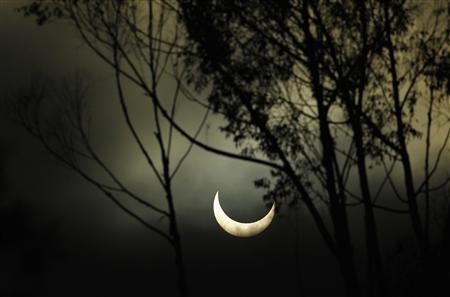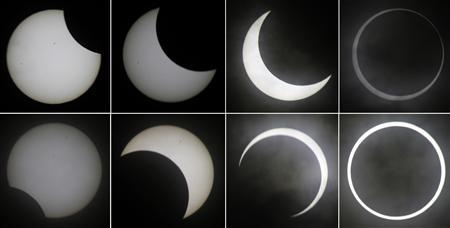
The sun and moon aligned over the Earth in a rare astronomical event on Sunday - an annular eclipse that dimmed the skies over parts of Asia and North America, briefly turning the sun into a blazing ring of fire.
The sun and moon aligned over the Earth in a rare astronomical event on Sunday - an annular eclipse that dimmed the skies over parts of Asia and North America, briefly turning the sun into a blazing ring of fire.
 |
| The moon passes between the sun and the earth as viewed through coastal fog rolling in from the ocean in Encinitas, California May 20, 2012. |
As the eclipse reached its peak, a crowd of several thousand viewers gathered in a Utah field took a collective gasp and erupted into applause, cheers and even some howling.
"The wonder of it, the sheer coincidence that this can happen, that totally amazes me," said Brent Sorensen, a physics professor at Southern Utah University, who brought a half-dozen telescopes to the rural town of Kanarraville for the public to peek through. "It never ceases to amaze me."
Eclipses of some type occur almost every year, but stargazers have not seen an annular - shaped like a ring -eclipse on U.S. soil since 1994, and the next one is not to occur until 2023. That is because the phenomenon requires a particular set of orbital dynamics, NASA Space Scientist Jeffrey Newmark said.
An annular eclipse occurs when the moon's orbit is at its furthest point from the Earth and closer to the much larger sun. That juxtaposition allows the moon to block more than 90 percent of the sun's rays when the two orbs slide into alignment.
"It's like moving your fist in front of your eyes," Newmark said. "You can block out the view of a whole mountain. It's the same kind of effect."
The eclipse was first visible over southern Asia and then moved across the Pacific. Traveling on a diagonal path, it later crossed parts of Oregon, Nevada, Utah, Arizona and New Mexico before disappearing in Texas with the sunset.
 |
| An eclipse (clockwise from top L) is seen in Tokyo May 21, 2012 in this combination picture. |
Day did not turn into night. But light faded as the moon slid in front of the sun, much like turning down a dimmer switch, and then slowly returned as the moon moved away.
A view of the so-called "ring of fire" spectacle at the eclipse's peak, however, lasted about four minutes, and even then was only visible to viewers positioned along the centerline of the eclipse's path.
UTAH 'SWEET SPOT' FOR VIEWING
In Utah, the "sweet spot" for viewing the full eclipse was Kanarraville, a community of just 355 residents about 230 miles south of Salt Lake City. Accessed by an old two-lane highway, the town has just two businesses - a campground and a nursery - plus a church, town hall and tiny post office.
Patrick Wiggins, who is part of the NASA ambassador outreach program, was overcome with emotion once the moon slipped into place. Wiggins had previously seen five total solar eclipses, but had never before witnessed an annular eclipse. He wasn't disappointed.
"I've been planning this since the 1980s," he said, his voice breaking. "You're seeing the solar system in motion."
Robin Kopaunik, 38, of Sandy, Utah, brought four of her children, ages 6 to 16, to see the eclipse in Kanarraville.
"It's so amazing. I think for them it's a chance of a lifetime," said Kopaunik, who home-schools her kids. "The best way to learn is to come out and see it."
A T-shirt salesman said his customers hailed from as far away as Brazil and Japan. Domestically, Edward and Jean Eadurka drove out from Virginia for the eclipse, after Ed's last attempt to see an annular eclipse, in 1994, was thwarted by cloud cover.
Jean said her 66-year-old husband was so enamored with the skies that he built himself a personal observatory - a backyard shed with a retractable roof - and often spends the whole night looking through his telescope.
"I'm an astronomy geek, I guess," said the retired court administrator, who once took an Atlantic Ocean cruise to see a solar eclipse. "I've been doing this so long it's compulsive."
Area officials said thousands more astro-tourists had been expected to attend so-called "star parties" at other locations across the region, including Zion National Park, Bryce Canyon National Park and Cedar Breaks National Monument.
Despite the infrequent nature of an annular eclipse, it was part of the normal astronomical cycle, said Inese Ivans, an assistant professor of astronomy and astrophysics at the University of Utah. Still, she said it was bound to pique curiosities and inspire awe.
"It reminds us that the Earth is spinning. That everything is constantly in motion," Ivans said. "This sort of gives you a chance to step out and remember ‘Oh yeah' there (is) a lot of stuff out there that we don't know anything about."
(Source: Reuters)




